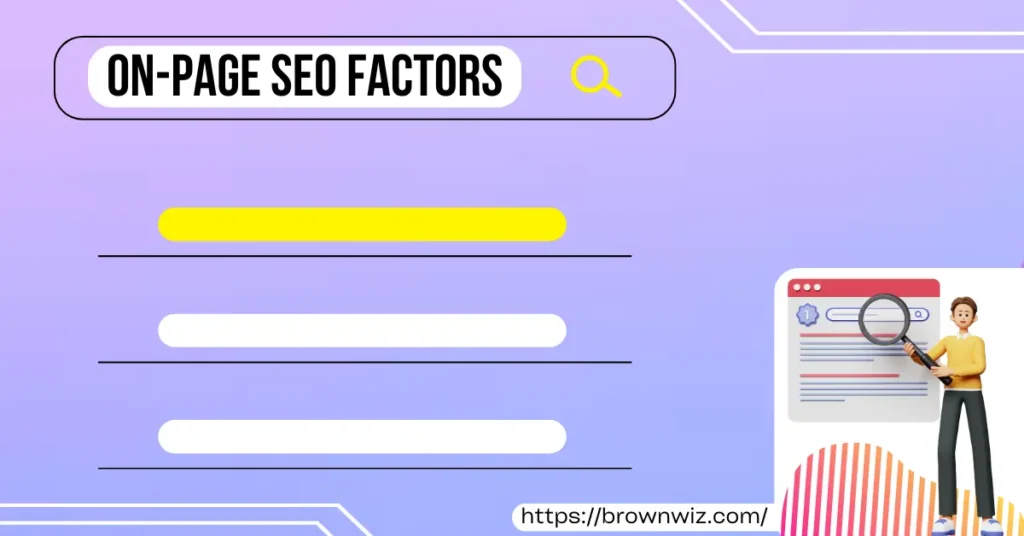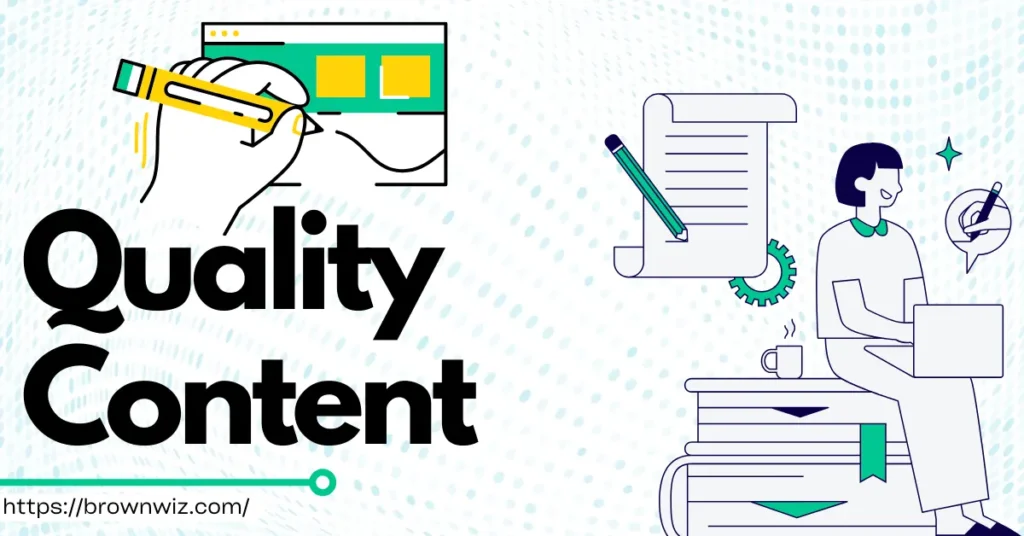If you’re new to SEO, you’ve probably heard the term “on-page SEO” being thrown around a lot.
But what exactly is it, and how can you use it to improve your website’s ranking?
What is On-page SEO?
On-page SEO refers to optimizing web page content and structure to make it more search engine friendly and improve its ranking on search engine results pages (SERPs).
This includes optimizing the HTML source code, internal linking, and content relevance and quality.
In simpler terms, on-page SEO means making sure that your website is structured and written in a way that search engines can easily understand what it’s about and how relevant it is to certain search queries.
Optimizing your website’s on-page elements can increase its visibility on search engines and attract more organic traffic.
Does On-Page SEO Matters?
In the online world, visibility is everything. You could have the most amazing website with revolutionary content, but if no one can find it, it’s like shouting into the void.
This is where SEO comes in, and within the SEO realm, on-page SEO shines as a beacon of digital optimization. But does it truly matter?
This article breaks down why On-Page SEO is crucial and how it helps a website succeed.
On-Page SEO Helps In Better Ranking On Search Engines
On-Page SEO is all about making sure search engines like Google can easily find, understand, and show your webpage when people search for things. This boosts the chances of your webpage popping up in search results.
Picture this: you’ve created amazing content for your website, but no one seems to find it. It’s like shouting in an empty room.
That’s where on-page SEO comes in – it’s your ticket to climbing the search engine ladder and getting your website seen.
SEO is not about Robots, User Experience Matters the Most
SEO isn’t just about appeasing robots; it’s about creating a fantastic experience for people who visit your website. On-page SEO helps you achieve this by ensuring your content is easy to read, navigate, and understand.
A good website isn’t just about attracting people; it’s about keeping them happy. On-Page SEO makes sure your site is easy to use. Fast-loading pages, clear content, and smooth navigation all contribute to a better user experience.
Search engines love websites that make visitors happy.
Organic Traffic Growth with the help of On-Page SEO
Good on-page SEO tells search engines exactly what your website is about, increasing the chances of it showing up when someone searches for something related. It’s like putting up a neon sign that screams
“Hey! I have what you’re looking for
- Improves page relevance for target keywords so search engines know what the page is about.
- Allows better keyword targeting and density to rank for specific user intent queries.
- Boosts page speed and technical elements for better user experience.
- High-quality, unique content remains a top ranking factor.
- Title tags, headings, URLs impact click-through-rate from SERPs
On-page SEO isn’t just a one-time thing; it’s an ongoing process of improvement. But trust me, the rewards are worth it.
By optimizing your website for both search engines and user experience, you’re paving the way for a thriving online presence.
On-page SEO Factors:

On-page SEO refers to the optimization of individual web pages to rank higher in search engines and earn more traffic.
This involves optimizing both the content and HTML source code of a page. On-page factors such as keyword usage, meta tags, header tags, and content quality all play a crucial role in search engine ranking.
To help you get started, here are some key elements of on-page SEO to focus on:
URL Structure:
Your URL structure should be clear and descriptive. Use hyphens to separate words and make sure to include your primary keyword in the URL.A good URL structure is designed to be clear, concise, and descriptive, reflecting the content and purpose of the page.
Elements of a URL may include the protocol (such as “https://”), the domain name (like “example.com”), and additional path segments that specify the page or location within the website.
A well-organized and readable URL contributes to better user experience, search engine optimization, and overall website organization.
Page Title
The page title is like the headline of a webpage. It’s the main text you see at the top of your browser when you visit a website. This title is also what appears as the clickable link on search engine results pages.
A good page title is usually short, under 60 characters, and should give a clear idea about what the webpage is about. It’s an important element for both users and search engines to understand the content of the page.
Meta Description:
The meta description is a summary of your page’s content that appears below the title tag in search engine results. It’s important to include your primary keyword in the meta description and keep it under 155 characters.
Heading Tags
Heading tags are like titles and subtitles for different sections of a webpage. They are part of the HTML code that structures the content on a page. The most important heading is usually labeled as H1, and it represents the main title or headline of the page.
Subsequent headings are labeled as H2, H3, and so on, indicating decreasing levels of importance.These heading tags not only help to organize content for readers but also provide valuable information to search engines about the structure and hierarchy of the content on a webpage.
Including relevant keywords in heading tags can further enhance the page’s visibility in search engine results.
Content Quality:
Content quality is the most important factor of on-page SEO. Your content should be unique, relevant, and informative. Use your primary keyword in the first 100 words of your content and aim for a keyword density of 1-2%.
- Well-written, informative, and unique content.
- Use relevant keywords naturally without overstuffing.
- Ensure easy readability with clear structure and layout.
- Adjust content length based on the topic’s needs.
- Capture interest with valuable information and multimedia elements.
- Keep content directly related to the page’s topic.
- Anticipate and address potential user questions.
- Include internal links for navigation and structure.
- Ensure content displays well on mobile devices.
- Use images, videos, or other media for engagement.
Keyword Research:
Keyword research is the foundation of on-page SEO. You need to find the right keywords to target in your content.
Use tools like Google Keyword Planner or Ahrefs to identify keywords related to your niche that have a decent search volume and low competition. Once you have your list of keywords, make sure to use them strategically throughout your content.
Use LSI Keywords
LSI (Latent Semantic Indexing) Keywords are words or phrases that are semantically related to the main topic or keyword on a webpage.
In simpler terms, LSI keywords are words that are commonly found together with your main topic. For example, if your main keyword is “apple,” LSI keywords might include terms like “fruit,” “orchard,” or “nutrition.”
Image Alt Tag
An image alt tag, or alternative text, is a descriptive attribute added to an HTML image element to provide text-based information about the content of the image. This text serves as a substitute when the image cannot be displayed, and it is also used by screen readers to assist visually impaired users in understanding the content of the image.
Including meaningful alt tags is a good practice for web accessibility and ensures a better understanding of your content by both users and search engines.
Page Speed
Page speed refers to the time it takes for a webpage to load and display its content fully. It is a critical factor in the user experience, as faster-loading pages generally provide a better and more satisfying experience for visitors.
Page speed is influenced by various factors, including the size and optimization of images, the complexity of the webpage’s code, server response times, and the efficiency of browser rendering. Websites with faster page speeds tend to have lower bounce rates and higher user engagement.

Mobile Friendliness
Mobile-friendliness refers to the design and functionality of a website to ensure that it works well and provides a good user experience on mobile devices such as smartphones and tablets.
A mobile-friendly website is responsive, meaning that its layout adjusts dynamically based on the screen size and orientation of the device.
Internal And External Links
An internal link is a hyperlink that points to another page or resource within the same website or domain. These links help users navigate through different sections or pages of the same site.
An external link, also known as an outbound link, is a hyperlink that directs users to a different domain or website. When you click on an external link, it takes you to a page outside the current website
Schema Markup
In simpler terms, it provides a way to give search engines additional information about the content and context of a page beyond what is visible to users.
Schema markup uses a standardized set of tags or microdata to label and categorize different types of information on a webpage. This can include details about products, reviews, events, recipes, and more
Local SEO
Local SEO, or Local Search Engine Optimization, is a set of strategies and techniques aimed at improving the online visibility of local businesses in search engine results. The primary goal of local SEO is to enhance a business’s presence in local searches, making it more accessible to users in a specific geographic location.
Voice Search SEO
Voice search refers to the use of spoken words to initiate a search query on a digital device, such as a smartphone, smart speaker, or other voice-activated technologies.
Instead of typing keywords into a search engine, users can verbally ask questions or give commands to their devices, and the device’s built-in voice recognition technology processes the spoken language to generate search results.
Including these related terms in your content helps search engines recognize the breadth and depth of your topic, improving the overall context and relevance of your page.
Quality Content With Search Intent Helps in On-Page SEO
On-page SEO refers to the techniques and strategies that are applied directly on a web page to optimize it for search engines. The main goal of on-page SEO is to make the content and structure of the web page more search engine-friendly and user-friendly.
This can include optimizing the page titles, meta descriptions, headings, content, images, internal links, and other on-page elements.

In terms of content, on-page SEO emphasizes the importance of high-quality, relevant, and engaging content that satisfies the user’s search intent.
This means that the content should be written with the user in mind and should aim to answer their queries and provide value. The content should also be optimized with keywords and structured in a way that is easy for search engines to crawl and index.
How to write website-friendly Content
When it comes to creating website content, certain elements can help improve your website’s on-page SEO. Here are some tips for writing website-friendly content:
Focus on Relevant Keywords:
Start by conducting keyword research to determine the keywords and phrases that your audience is searching for. Incorporate these keywords into your content naturally and organically.
Use Headings and Subheadings:
Break up your content into easily digestible sections using headings and subheadings. This helps to improve readability and makes it easier for search engines to understand the structure of your content.
Optimize Your Meta Data:
Make sure your title tags and meta descriptions accurately reflect the content on your website. These elements show up in search engine results and can impact click-through rates.
Create Quality Content:
Make sure your content is high-quality and provides value to your audience. This can lead to more shares and backlinks, which can ultimately improve your website’s ranking in search engine results.
Include Images and Videos:
Incorporating images and videos into your content can help to break up text and make your content more engaging for your audience. Additionally, optimizing your images and videos can also improve your website’s on-page SEO.
By focusing on these on-page SEO elements, you can help improve your website’s visibility in search engines and drive more traffic to your site. Remember to create content for your audience first and optimize for search engines second.
Want to learn How Google search works?
Read Our SEO Guide- SEO- How It Works, Why It Matters, Types, Ranking Factors, And Example
Why is On-Page SEO Important?
On-page SEO is important because it helps search engines understand what your page is about and determine if it’s relevant for a user’s search query. Proper on-page SEO improves your chances of ranking well in search results..
How to do On-Page SEO?
Some key ways to do on-page SEO include optimizing title tags, meta descriptions, headings, content, URLs, structured data markup, internal linking, and more. Focus on providing a great user experience with relevant, high-quality content.
How to Optimize Title and Description Tags?
Your title tag and meta description summarize the topic of a page. Keep titles under 60 characters, unique, and include important keywords. Meta descriptions can be 1-2 sentences or 150-160 characters that compel users to click.
Why use a Unique keyword-rich meta description?
Unique meta descriptions with keywords help search engines understand the content focus and topic relevancy of a page. They also influence click-through-rates from search engine results pages.
How to optimize content for SEO?
Ways to optimize content include using keywords appropriately in the first 100 words, wrapping key phrases into headings (H2, H3), maintaining a keyword density of 1-2%, and placing keywords in URLs, file names, image alt text.
How do headings help SEO?
Headings (H1, H2, H3) break up text into logical sections and highlight keywords and topics covered on the page. Use keywords appropriately in headings.
How does Schema Markup help SEO?
Schema markups like Review, FAQ, and How-To help search engines better understand the content. This can lead to rich result previews, featured snippets, and improved click-through-rates.
How to optimize URLs?
Keep URLs short, hyphenated, lowercase, and keyword-rich. For example example.com/keyword-focused-page-title. Avoid overstuffing URLs with keywords.
Why is Internal Linking Important?
Internal links allow you to pass authority and SEO value between pages on your site. Link relevant pages using keywords appropriately for anchor text.
